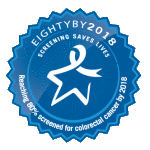
Colorectal Cancer (CRC) is the third most commonly diagnosed cancer and the third leading cause of cancer deaths in both men and women in the United States. Although the incidence of colon cancer has declined significantly over the past ten years; largely due to improvements in screening and early detection, rates of CRC remain high in the Midwest. The four states served by the Great Plains Quality Innovation Network (QIN) — Kansas, Nebraska, North Dakota and South Dakota — continue to have CRC incidence rates that are higher than the national average and CRC screening rates that are far below the national average.
 We are working in support of the National Colorectal Cancer Roundtable’s “80% by 2018” initiative, which aims to reduce the number of new colon cancer cases and avoidable deaths nationwide by getting 80 percent of patients screened in each state. A systematic approach designed to identify and provide a recommendation to every eligible patient who visits a practice for any reason is key to reaching the 80% goal. As such, we are promoting the implementation of“The Four Essentials for Improving Colorectal Cancer Screenings” to practices:
We are working in support of the National Colorectal Cancer Roundtable’s “80% by 2018” initiative, which aims to reduce the number of new colon cancer cases and avoidable deaths nationwide by getting 80 percent of patients screened in each state. A systematic approach designed to identify and provide a recommendation to every eligible patient who visits a practice for any reason is key to reaching the 80% goal. As such, we are promoting the implementation of“The Four Essentials for Improving Colorectal Cancer Screenings” to practices:
- Make a recommendation. According to the American Cancer Society (ACS) and the National Colorectal Cancer Roundtable, a physician’s recommendation is the single most influential factor in persuading individuals to be screened for cancer.
- Develop a screening policy. Office policies are the foundation of a systematic approach and should be designed to fit the practice. A policy that incorporates the considerations of risk level, insurance coverage, local medical resources, and patient preference will lead to the best screening choice for each patient.
- Be persistent with reminders. Practices are more effective with the use of reminder systems, which are evidence-based and demonstrated to be effective. Both provider-directed and patient-directed systems contribute to improved screening rates.
- Measure practice progress. Practices need to establish their baseline screening rate and set ambitious practice goals. Seeing screening rates improve can positively reinforce the implementation of process changes to reach practice goals.
The Great Plains QIN has aligned with the ACS, local ACS affiliates, Centers for Disease Control and Prevention grantees, and the Health Information Exchanges in each of its four states, as well as partnered with the Great Plains Tribal Chairman’s Health Board and local public health units on or near the tribal areas to support efforts to improve CRC rates within its Native American population.
In addition, we have developed maps of colorectal cancer screening rates for each of our four states (by county). Screening rates include Colonoscopies, Sigmoidoscopies, FOBTs and Barium Enemas. Percentages are based on Medicare claims data (2015). You can access these maps on our Web site. We plan to update each quarter once new data is available.
To learn more about the Great Plains QIN’s efforts to improve colorectal cancer screening rates, visit our Web site or contact Tasha Peltier in North Dakota, Denise Kolba in South Dakota, Jennifer Geisert in Nebraska or Kaitlin Nolte in Kansas.
